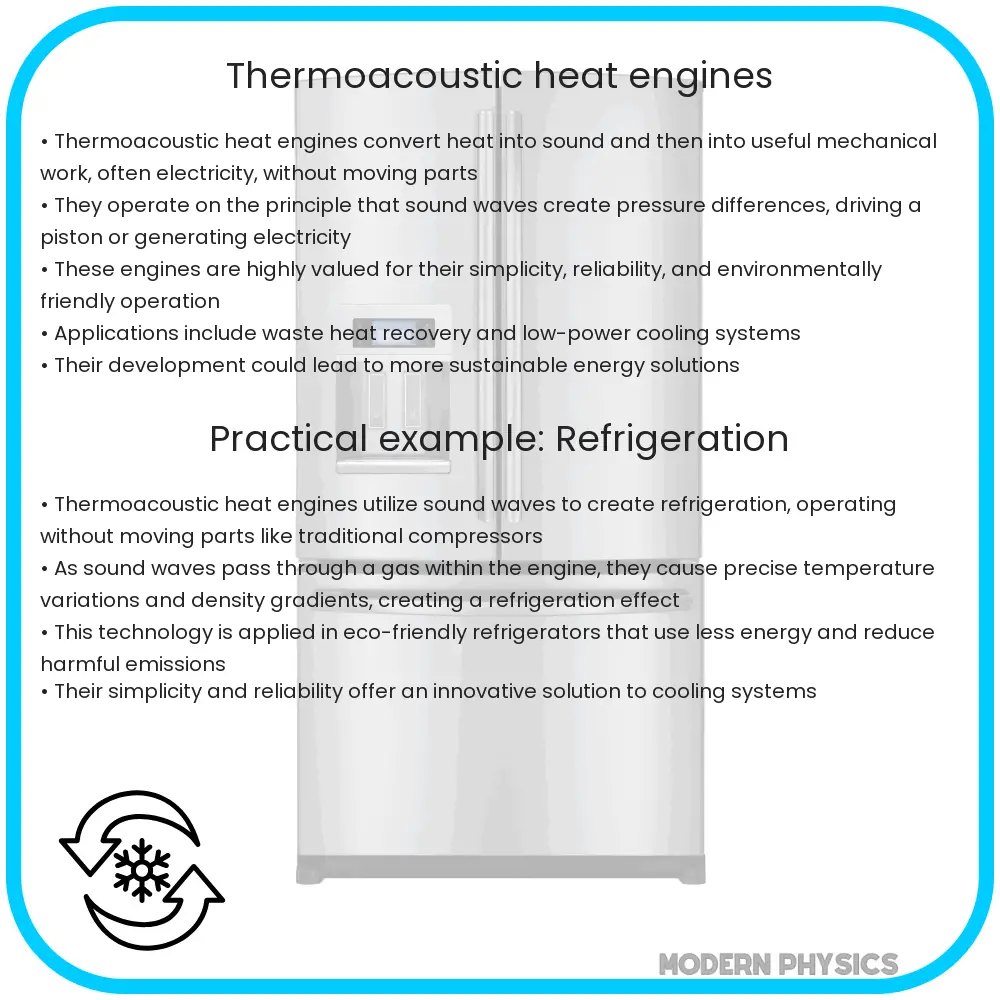Thermoacoustic heat engines convert thermal energy to acoustic energy, and then to mechanical work or electricity, using the principles of thermodynamics and acoustics.

Introduction to Thermoacoustic Heat Engines
Thermoacoustic heat engines are a fascinating advancement in the field of energy conversion technology. These engines convert thermal energy into acoustic energy and ultimately into mechanical work or electricity, without the need for moving parts. This simplicity leads to numerous benefits including higher reliability, lower maintenance costs, and a reduction in environmental impact. These systems harness the principles of thermodynamics and acoustics, providing a unique and efficient way to generate power.
How Thermoacoustic Heat Engines Work
The underlying mechanism of a thermoacoustic heat engine involves complex interactions between heat and sound waves within a gas medium. The process can be split into three primary stages:
- Heating and Cooling: The engine consists of a resonator tube filled with gas, along with carefully placed heat exchangers. One heat exchanger is kept at a higher temperature and the other at a lower temperature. As the gas comes into contact with the hot surface, it expands and when it encounters the cold surface, it contracts.
- Generation of Sound Waves: This rapid expansion and contraction generates pressure waves or sound waves. The key component, called the ‘stack’, positioned inside the resonator, has its materials chosen and spaced apart so that the temperature gradient across it helps amplify these sound waves effectively.
- Conversion of Sound Energy: The intensified sound waves are then utilized to do mechanical work. For example, in some configurations, the acoustic waves drive a piston or drive electromagnetic devices that convert the acoustic energy into electricity.
Thermoacoustic Models and Key Parameters
The effectiveness of thermoacoustic engines is often evaluated through various models, primarily the standing wave and traveling wave models. Each model utilizes different configurations of the stack and heat exchangers but operates under the common principle of phase difference manipulation between temperature and pressure waves to maximize energy conversion.
Some critical parameters in optimizing a thermoacoustic engine include:
- Stack Position: The location where the stack is placed significantly affects performance. Placing it too close to either heat exchanger might dampen the sound waves too much.
- Sound Frequency: The frequency of the sound waves also plays a crucial role. Proper tuning of the engine resonator helps in achieving optimal interaction between heat and sound waves.
- Temperature Gradient: The efficiency of the engine is directly proportional to the temperature differential imposed by the heat exchangers. Higher gradients typically lead to more powerful wave propagation.
This innovative technology not only challenges our traditional ideas of mechanical engines but also opens up new possibilities in sustainable energy practices. Thermoacoustic devices, due to their simplicity and use of fewer moving parts, hold promise for long-lasting and maintenance-free operation, especially in harsh or remote environments.
Applications of Thermoacoustic Heat Engines
Thermoacoustic heat engines have a broad range of potential applications, making them a versatile technology in today’s energy landscape. Here are some notable areas where these engines can be applied:
- Power Generation: These engines can be used in remote areas where traditional power sources are impractical. They utilize local heat sources, such as solar heat or biomass, to generate electricity.
- Refrigeration: By reversing the working principle of thermoacoustic engines, they can be used to create refrigeration systems, known as thermoacoustic refrigerators, which are ideal for use in environments where reliability and low maintenance are crucial.
- Waste Heat Recovery: Industries that produce a large amount of waste heat can use thermoacoustic engines to convert this heat into useful electric power, thus improving overall energy efficiency.
Challenges and Future Prospects
While thermoacoustic heat engines offer many advantages, they also face certain challenges that must be addressed. Some of these include:
- Scalability: Scaling these engines to larger sizes without losing efficiency poses a significant challenge.
- Material Costs: The cost and availability of materials suitable for high-temperature operations can affect the overall viability of these engines.
- Public Awareness: Increasing the awareness and understanding of this technology among potential users and investors is crucial for its widespread adoption.
Despite these challenges, ongoing research and development are leading to innovations in materials and design that promise to enhance the performance and reliability of thermoacoustic devices. The future of thermoacoustic heat engines looks promising as they continue to evolve into a more efficient and sustainable option for power generation and refrigeration.
Conclusion
Thermoacoustic heat engines represent a remarkable fusion of thermodynamic principles and acoustic science to create a unique and efficient form of energy conversion. From providing electricity in remote areas to offering innovative cooling solutions, these engines have a wide range of applications that could revolutionize various sectors. Despite facing scalability and material challenges, the continuous improvements and increasing interest in green technology suggest a bright future for this field. As research advances, thermoacoustic devices are set to become an integral part of our sustainable energy solutions, combining simplicity, reliability, and environmental benefits in one impressive technology.
